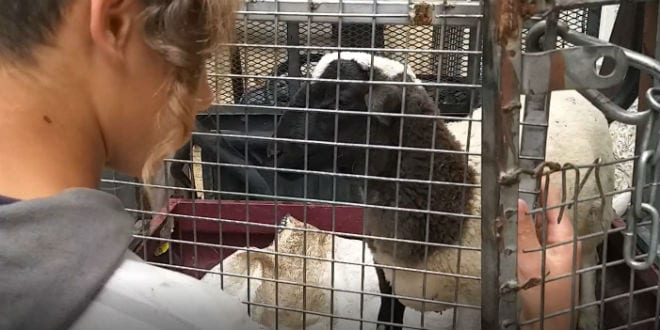The eighth annual reenactment of the Passover sacrifice took place in the Old City of Jerusalem on Monday evening. Approximately 1,000 people gathered in the Galicia Courtyard, a rooftop area over the Arab shuk (open-air market) in unseasonal rain. They were there to witness the Kohanim – in the Biblically mandated garb – perform the ceremony in a manner as close as possible to that of the time when the Jewish Temples stood.
The ceremony was accompanied by blasts from silver horns. A band played songs based on the Hallel service, a prayer service composed of verses from Psalms, that was sung in the Temple while the Passover sacrifice was being prepared.
A goat was slaughtered and its blood was collected in a special vessel designed with a pointed base so that it may not be placed down to rest. The blood was spilled out on a model of the altar.
In the Temple, the priests would arrange themselves in a line stretching from the courtyard in which the lambs were slaughtered stretching all the way to the altar. The blood from the sheep would be collected in a vessel and then passed from one priest to another, hand over hand, until it arrived at the altar upon which it was poured.

The goat was prepared roasted whole on a long pomegranate branch in the manner described in the Torah and served to the Jews gathered to witness the reenactment.
They shall eat the flesh that same night; they shall eat it roasted over the fire, with unleavened bread and with bitter herbs. Exodus 12:8
There are only two mitzvot (Biblical commandments) for which non-compliance receives the most severe punishment mandated by the Torah, karet (being cut off from the community, or excommunicated): brit milah (circumcision) and the korban Pesach (Passover sacrifice).
Mordechai Persoff, head of the Mikdash Educational Center, a non-profit organization for education about the Temple, helped organize the event. Persoff was thrilled with the reenactment but expressed disappointment in the actions of the government and authorities.

“We encountered difficulty at every step of the way, from every bureaucratic office involved,” Persoff told Breaking Israel News. “Last year, the event was held at the Davidson Center, which is at the base of the Temple Mount. The authorities did not allow us to do the reenactment anywhere near the Temple Mount this year.”
Davidson Center is an archaeological park on the southern wall of the Temple Mount. The park stands at the foot of the stairs where individuals walked up to bring their sacrifices to the Temple.
“Every single piece of paper, every form, was double and triple checked,” Persoff said. “The name of every person involved with organizing the event was recorded by the police.”
The event was delayed when the police officer overseeing security demanded that the original copy of the permit for slaughtering the lamb be produced in place of a faxed copy.
Persoff was encouraged by other improvements he has seen over the years.
“The event used to be treated as incitement by extremists,” Persoff said. “Several secular media and filmmakers are attending these events on a regular basis and have come to realize that this is not political or extremist. This is an educational reenactment of something that was an essential element of the Jewish people that is explicitly described in the Bible. When the media view the reenactment in that light, they are very accepting.”
Source: Israel in the News

